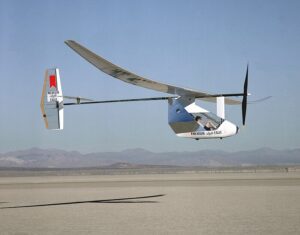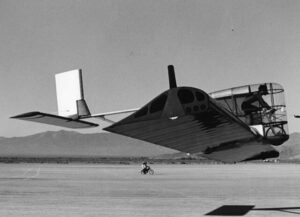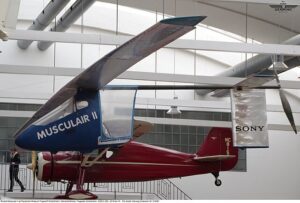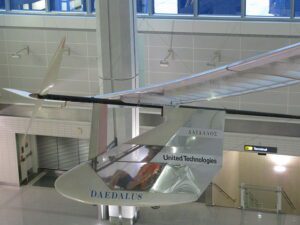
A human-powered aircraft – MIT Light Eagle
German inventor Karl von Drais introduced a revolutionary invention in 1817. He invented the first cycle, known as the “swift walker,” which laid the groundwork for future transportation innovations. The first cycle was a simple, pedal-less precursor to modern bicycles. Drais might have been impressed if he knew that his mode of traveling on the ground (i.e., pedaling/ bicycling) could now be used to take to the skies as well.
By powering aircraft the human way, i.e., by pedaling, we can reduce many of the environmental problems associated with traditional aviation. We don’t need to worry about the consequences of different types of (jet/SAF)fuel, and given that aircraft you can pedal your way around don’t have too many passengers on board, there’s no food waste in aircraft as well. Let’s explore the fascinating journey from the humble bicycle to the remarkable world of human-powered flight.
Early attempts and successful human-powered flights.
In the early 20th century, inventors experimented with human-powered flight. One notable example was the Gerhardt Cycleplane, designed by Dr. William Frederick Gerhardt in 1923 at McCook Field in Dayton, Ohio. The Gerhardt Cycleplane featured seven wings stacked nearly 15 feet high. The pilot pedaled a bicycle gear, which turned the propeller. Although it required assistance for takeoff, it achieved stable, level flight for short durations.

Fast forward to 1961, when the University of Southampton made history with the world’s first human-powered flight. The single-seat aircraft, built from balsa, plywood, and aluminum, featured cycle pedals mounted to the front. The pilot’s pedaling provided forward momentum on the ground and powered a large propeller during flight.
In 1934, Engelbert Zaschka from Germany completed a significant human-powered aircraft, the Zaschka Human-Power Aircraft. It flew about 20 meters at Berlin Tempelhof Airport, demonstrating the feasibility of human-powered flight.
The transition from cycles to cycle-operated flight involved engineering challenges, aerodynamic improvements, and innovative designs. These early pioneers paved the way for subsequent achievements in human-powered aviation. But what exactly are the ways we can power an aircraft non-mechanically?
What exactly is a human-powered aircraft (HPA)?
A human-powered aircraft (HPA) is a unique class of vehicle in which the pilot steers and provides propulsion by pedaling, similar to a bicycle or tricycle. Typically, the pilot’s feet turn a gear, which drives a bicycle chain, rotating a smaller gear connected to a vertical shaft. This shaft, in turn, either powers a propeller directly or drives a set of bevel gears that ultimately turn the propeller. Early attempts at human-powered flight faced challenges due to the need for an exceptionally high power-to-weight ratio.
While they are primarily engineering challenges rather than practical modes of transportation, some notable modern HPAs include Iron Butterfly and Zephyrus. These aircraft demonstrate the ongoing pursuit of efficient and sustainable flight through human effort.
How do the modern HPAs compare to historical ones?

Modern human-powered aircraft (HPAs) have made significant advancements compared to their historical counterparts. Modern HPAs benefit from lightweight materials such as carbon fiber composites, which enhance strength-to-weight ratios. Historical HPAs often used wood, fabric, and metal, resulting in heavier structures. Here are some key differences:
| Factors | Modern | Historic |
| Aerodynamics | Contemporary HPAs incorporate streamlined designs, optimized wing shapes, and efficient propellers. | Early HPAs had less sophisticated aerodynamics, limiting their performance. |
| Propulsion Systems | Modern HPAs feature improved transmission systems, minimizing energy loss between the pilot’s pedaling and the propeller. | Historical HPAs had less efficient transmission mechanisms, leading to power wastage. |
| Achievements | Recent HPAs have achieved longer flight durations and covered greater distances. | Historical HPAs achieved shorter flights, often just a few meters. |
.
In-depth process of how a human-powered aircraft works.
Let’s delve into the intricate workings of a human-powered aircraft (HPA).
Design and Structure:
HPAs are meticulously designed to be lightweight yet sturdy. They often feature a streamlined, elongated fuselage with a single-seat cockpit. The wingspan is typically long, which maximizes lift while minimizing drag. The wings may have a high aspect ratio for efficiency. Materials like carbon fiber composites, lightweight metals, and fabric coverings are used to keep weight to a minimum.
Propulsion System:
The heart of an HPA lies in its propulsion system, which relies entirely on human power. Like riding a bicycle, the pilot sits in the cockpit and pedals. The pedaling motion drives a transmission system, which converts the rotational motion of the pedals into rotational energy for the propeller.
Transmission Mechanism:
- A chain or belt drive connects the pedals to a central shaft.
- The central shaft runs vertically through the fuselage and connects to the propeller.
- Some HPAs use a series of gears to achieve the desired gear ratio, optimizing power transfer.
Propeller:
The propeller is usually located at the rear of the aircraft. As the pilot pedals, the propeller spins, generating thrust. The pitch of the propeller blades affects the efficiency of thrust production.

Takeoff, flight, and landing:
- To take off, the pilot pedals vigorously, building up speed.
- Once sufficient speed is attained, the pilot pulls back on the control stick to lift off.
- Due to their low power output, HPAs typically require a long runway for takeoff.
Maintaining altitude in an HPA is challenging due to the limited power available. Pilots aim for thermals (rising air currents) to gain altitude. Long, gliding descents are common, as the pilot conserves energy.
- Landing an HPA involves carefully descending and controlling the glide path.
- The pilot aims for a smooth touchdown, often on a grassy field.
- Ground crew members assist in stopping the aircraft.
Challenges that come with human-powered aircraft.
Human-powered aircraft (HPAs) present several engineering challenges due to their unique design and reliance on human muscle power. Here are some key challenges:

Low Power-to-Weight Ratio
The primary limitation is the low power output that humans can sustain. Unlike engines, which can provide continuous power, human muscles fatigue quickly. As a result, HPAs must be extremely lightweight to compensate for this limitation. Achieving an efficient balance between power generation and weight is crucial.
Limited Lifting Power
Humans can only generate a finite amount of lift through pedaling or other means. This restricts the aircraft’s payload capacity and overall performance. Designing wings and propellers that maximize lift while minimizing drag is essential.
Aerodynamic Efficiency
HPAs require efficient aerodynamic designs to minimize drag and maximize lift. Ornithopter principles (mimicking bird flight) were initially explored but proved too heavy and aerodynamically inefficient. Modern HPAs use propellers driven by pedal power, but optimizing their shape and size remains challenging.
Stability and Control:
It is easier to maintain a stable flight with an engine. HPAs must be inherently stable and controllable. Achieving stability during takeoff, landing, and maneuvers is critical.
Figure-Eight Course:
While HPAs have successfully flown straight-line courses, attempting more complex maneuvers like figure-eight patterns remains challenging. These require precise control and coordination.
Human Endurance:
Since human power is limited, HPAs have low cruise speeds. Pilots must endure physical strain during flight, especially during takeoff and climb. Achieving sustained strain during flight in low winds requires physical fitness and skill.
How did bicycles influence early aviation design?
The influence of bicycles on early aviation design is a captivating story. Cyclists in the early 20th century could already experience a form of “flight” on their bicycles, coasting at an altitude of about five feet. Bicycle advertisements featured riders merrily soaring through the air, and some bikes were even named “flyers.” Ministers likened cycling to heavenly flight, emphasizing the sensation of riding upon the wind.
Just as the bicycle created a demand for powered land transportation, it also fueled a thirst for powered flight. While many scientists considered heavier-than-air flight impossible, some cyclists saw it as the natural next step. The bicycle introduced humans to the feeling of flying, creating a precedent for inventing airplanes.
Bicycle Mechanics and Flight:
- The logic was that bicycle inventors would solve the mystery of flight.
- Charles Duryea, a bicycle maker, even designed a pedal-powered helicopter, envisioning it as an evolution of bicycle technology.
- Although Duryea’s 200-pound machine was never built, the idea persisted that bicycle mechanics could lead to revolutionary new flying vehicles.
The bicycle not only transformed land transportation but also inspired early aviators, shaping the path toward the invention of the airplane.
Some notable records set by human-powered aircraft.
Human-powered aircraft (HPA) have achieved remarkable feats over the years. Here are some notable records:
Musculair II:
-
- Speed Record: Holger Rochelt, a German pilot, achieved the world record for the highest speed in a human-powered aircraft.
- Speed: He reached an impressive 44.26 km/h (27.5 mph) while flying the Musculair II on October 2, 1985.

Daedalus 88:
-
- Distance and Duration Record: The Daedalus 88 holds the FAI world record for both distance covered and duration of human-powered flight.
- Flight Details: It covered an astonishing 71.5 miles (119 km) in just under four hours, flying from Iraklion on Crete to Santorini.

Conclusion
HPAs showcase human ingenuity, determination, and the desire to conquer the skies using our own physical power. These achievements inspire future generations and celebrate the spirit of exploration. Research on HPAs contributes to aerodynamics, lightweight materials, and energy efficiency. Lessons from HPAs can inform the design of more sustainable and efficient conventional aircraft. The concept of human-powered flight could inspire innovations in urban mobility, personal transportation, and recreational aviation. In summary, HPAs bridge the gap between human capability and technological advancement, leaving a lasting legacy and inspiring progress in aviation and beyond!
